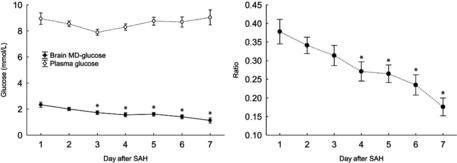Critical Care Medicine
Adult Critical Care
Relation between brain interstitial and systemic glucose concentrations after subarachnoid hemorrhage
Zetterling M, Hillered L, Enblad P, et al (Uppsala Univ, Sweden) J Neurosurg 115:66-74, 2011§
Evidence Ranking
• B
Expert Rating
• 2
Abstract
Conclusions
After SAH, there was a positive correlation between plasma and MD glucose concentrations with a high degree of individual variation. A gradual decline in MD glucose and the MD/plasma glucose ratio and an increase in MD pyruvate and MD lactate concentrations during the 1st week after SAH suggest a transition to a hyperglycolytic state with increased cerebral glucose consumption. The administration of insulin was related to a lowering of MD glucose and MD pyruvate, often to low levels even though plasma glucose values remained above 6 mmol/L. After SAH, the administration of insulin could impede the glucose supply of the brain (Figs 2 and 3).
Stay updated, free articles. Join our Telegram channel

Full access? Get Clinical Tree




